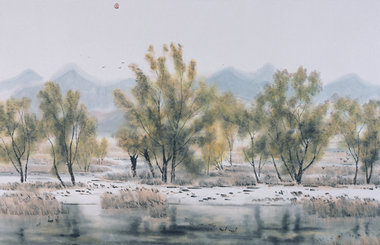An enemy is turned back - with plants as weapons
By Yang Yang ( China Daily ) Updated: 2017-07-29 07:13:10For several decades people who live along the Hexi Corridor in northern China have fought to halt the desert as it spreads, and they have notched up significant victories.
To the eye, the barren landscapes of loess plateau in the city of Lanzhou, Gansu province, were at once grand and heart rending, with an endless string of yellow mountains that Mother Nature seems to have given up on. Long scars formed by water erosion run from the top of the mountains down through the surface, adding to the picture of desolation.
In Yuzhong county of Lanzhou, the 300 millimeters of rain that fall each year washes loose earth down the mountains and into the Yellow River in torrents that run through Lanzhou.
Yet locals have managed to grow 253-sq km of caragana on the sunny and semi-sunny slopes of the loess mountains. The plants survive easily in the dry soil, with a life span of decades and some even projected to live for more than 100 years. Cargana's roots run deep into the soil, as much as three meters, and helps to fix soil, preserve 34 percent of rainfall and reduce surface erosion by more than two thirds.
The contrast between these mountains - those covered with flourishing plants and those covered with unsightly scars - is as clear as the difference between life and death.
Gongjing Tree Farm in Yuzhong is located on a tributary 37 kilometers from the Yellow River. It is one of the major sources of sediment in the river, whose tattered surrounding landform, loose soil and sparse vegetation cause severe water and soil loss.
Since 2013 local people have planted more than 3 million trees and dug 6 million holes to grow plant seeds. More than 75 percent of the seeds and their offspring have survived. Apart from shrubs such as caragana, they also grow Chinese thuja, Siberian apricot, Scots pine and elm - plants that can endure drought.
Over the same period, average annual rainfall in the region has risen from 280 mm to 330 mm.
Efforts by the locals have not only helped improve the natural environment, but have helped many make a living, for example by raising chickens in the areas where the trees they planted grow. From 2014 to 2017, 60 percent of a 20 million yuan ($3 million) government land care fund was paid in wages to locals.
|
|
|
|
|
|
|
|

























 Raymond Zhou:
Raymond Zhou: Pauline D Loh:
Pauline D Loh: Hot Pot
Hot Pot Eco China
Eco China China Dream
China Dream China Face
China Face






